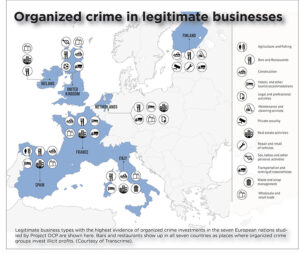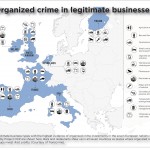Organized crime in Europe: A country-by-country breakdown

Organized crime in Europe: A country-by-country breakdown
The second of three parts on the state of organized crime in Europe.

In April, the Joint Research Center of Transnational Crime, based in Trento, Italy, released a comprehensive report on European organized crime titled, “From Illegal Markets to Legitimate Businesses: The Portfolio of Organized Crime in Europe.” Funded by the European Union, the report, known as Project OCP, was prepared with input from law enforcement authorities in the countries participating in the study: Finland, France, Ireland, Italy, the Netherlands, Spain and the United Kingdom.
Proceeds from all illicit markets, including ones run by organized crime, in the twenty-eight countries of the European Union were estimated to be at least $120 billion. But that estimate is low. In some EU countries, some markets, such as human trafficking, illegal gambling, match fixing, extortion racketeering and money lending, could not be measured.
Project OCP focused on illicit markets in the seven countries where estimates were generally available, including drug trafficking (heroin, cocaine, cannabis, ecstasy and methamphetamine), human trafficking, firearms trafficking, tobacco trafficking, counterfeiting, extortion racketeering, fraud and organized property crime, as well as the theft of Value Added Tax (VTA) levies in some of the countries.
Part 1 of our three-part examination of the Project OCP study summarized the report. Part 2 is a review of the report’s findings on each of the participating countries:
Finland
Organized crime in Finland can be traced to the 1920s but its impact was not felt until much later, and in an unusual way compared with other EU countries. Outlaw motorcycle gangs, or OMGs, which entered Finland in the 1990s and expanded in the 2000s, now dominate organized crime activities there. The primary actors are commonly known groups from the United States, the Hells Angels, Banditos and Mongols, with drug trafficking and fraud — from tax evasion to black market labor — being the most profitable markets, followed by the laundering of the proceeds.
The expansion of OMGs in Finland has been rapid, centered mostly in the southern part of the country near Sweden and shipping ports. In 2013, sixty chapters with 1,000 members were identified, up from only eight chapters in 2000. OMGs in Finland, including the Finnish-based groups Cannonball MC and United Brotherhood, commonly cooperate with each other. They conduct business within defined hierarchies, with president, vice president, other officers and low-level “hangarounds” who are often selected to do the gangs’ dirtiest deeds. Individual gangs tend to specialize in certain criminal activities, primarily contract violence, extortion, violent loan collection and money laundering.
The largest source of money for organized crime in Finland, which aside from OMGs also involve OC groups from Africa, Russian and Eastern Europe, is illegal sales of heroin, cocaine, marijuana and other drugs, estimated at as high as $340 million a year.
France
France’s geographic position in virtually the center of Europe has made it a “transit country” for the movement of illegal drugs along drug trade routes, specifically cannabis and cocaine from North Africa and neighboring Spain to Northern Europe and cannabis, cocaine, heroin and synthetic drugs from the Netherlands to southern Europe. France, made famous as the so-called “French Connection” hub for heroin dealing going back to the 1930s, today plays a lesser role in heroin but remains a transit area for the drug. Proceeds from drug smuggling as a whole in France are estimated at up to $5.4 billion annually, perpetrated by African, Albanian, Dutch, French, ‘Ndrangheta, Turkish and Asian organized crime groups and outlaw motorcycle gangs
“France appears, together with Spain, to be one of the European countries attracting the widest range of OCGs,” according to authors of the study.
The country is also a leader in the business of counterfeit goods, from clothing to food, and the illicit tobacco trade. France’s location also makes it a haven for the trafficking of human beings, some for forced labor but also young girls, from places such as Albania, Moldova and Eastern Europe, for sexual exploitation in Belgium, the U.K., the Netherlands, Germany and Italy.
France’s illicit economy involves many international organized crime groups present in other EU nations, but also its home-grown syndicate, the grand banditisme traditionnal, or “grand banditry.” Based in southern France and Corsica, the grand banditry has its hands in criminal enterprises such as drug dealing and extortion. Criminal gangs of North African – specifically Moroccan — origin or linked to North African organized crime are in the so-called “difficult suburbs” of large French cities and mainly facilitate drug dealing via the Netherlands-France and Morocco-Spain-France trafficking routes.
Syndicates engaged in the trafficking of cannabis – France’s top illegal drug – and cocaine include Turkish, Albanian, Nigerian, Dutch OCGs and more recently ‘Ndrangheta and other Italian Mafias. Actors in the lucrative market of counterfeit goods in France are Chinese, Italian and Turkish OCGs. The human trafficking market through France involves African, Albanian, Bulgarian, Chinese, other East European, North African and Asian OCGs, as wells as Romanian, Russian/Georgian and South American OCGs.
In all, revenues from France’s illicit markets amount to as much as $23 billion, as high as $6 billion from counterfeiting alone.
Ireland
From available studies on organized crime in Ireland, estimates of annual revenues from illicit markets are relatively modest, about $2.5 billion at the most, nearly half from drug trafficking and about $500 million from counterfeit goods. Ireland is used as a strategic transit country for drug smuggling to the U.K. and EU nations. The country also ranks high in the domestic consumption of illicit cannabis, heroin and cocaine. Sea shipments of cannabis from Morocco arrive for distribution by local Irish criminals working with Russian OCGs based in Spain. Sales of cannabis by Chinese and Vietnamese OCGs in Ireland from indoor grow operations are increasing.
Irish Police have identified nine OCGs in Ireland, and Interpol found about forty Irish criminal gangs operating in Europe, mainly linked to foreign criminal groups, such as Russian, Chinese and East European OCGs and with the Netherlands, Spain and the U.K. being key locations for their criminal activities. Ireland’s OCGs are mainly located in urban areas such as Dublin and Cork, engaged in drug trafficking and vehicle thefts. Another trend is former members of disbanded Irish paramilitary dissident groups who once committed acts of terrorism but now entering illicit markets such as overseas trafficking of cigarettes through shipping containers.
Ireland is also an end location for the trafficking of humans from Nigeria, Albania, Eastern Europe, China and Southeast Asia who are exploited by individuals or OCGs of the same ethnicity, specifically for prostitution in brothels or apartments. Brothels run by foreign OGCs are said to be on the increase in Ireland. The country’s OCGs have recorded the highest number of frauds using payment cards in the EU. VAT avoidance fraud amounts to about $185 million a year. Other common illicit markets include organized vehicle theft, cargo theft and fuel smuggling between Ireland and Northern Ireland.
Italy
Authors of Project OCP state that “illicit markets in Italy are huge in scale,” in part because of Italy’s large legitimate economy as a whole (Italy’s gross domestic product is third in the EU behind Germany and France) and because its strategic location and coastlines provide OCGs with routes for illicit markets in drugs, human trafficking, tobacco, firearms and counterfeit products from North Africa to the Balkans. Another major factor is “the historical presence of permanent and well-rooted OCGs, especially Italian Mafias, particularly in the southern regions,” the authors state. OCG revenues in Italy, based on rough low-to-high income ranges estimated in many studies, could be as low as $32 billion or upwards of more than $60 billion.
In a category not usually associated with other EU nations, illegal gambling – from, for instance, gaming machines run by Camorra OCGs – represents a market projected at $10 billion. Studies have indicated that income ranges of Italy’s other illegal markets are vast – as high as more than $25 billion in drug trafficking (including up to $3.6 billion in heroin sales, $11.3 billion to nearly $14 billion from cocaine and as much as $7.7 billion from cannabis); up to $5 billion from human trafficking; $5 billion to $8.6 billion in counterfeit goods dealing; more than $5 billion in extortion and racketeering, $5 billion to $16 billion in illegal loans; and at least $5 billion in fraud such as VAT evasion.
The study separated the OCGs in Italy by region: southern, central and northern. The southern part of the country is dominated by traditional Italian Mafias – the Camorra in the state of Campania, ‘Ndrangheta in Calabria and Cosa Nostra in Sicily – that operate only occasionally with foreign OCGs. Foreign syndicates, such as Chinese OCGs with investments in counterfeiting and sexual and forced labor exploitation in Tuscany, are present in Italy’s central region, although the Camorra works within Umbria, Molise and Abruzzo. The Camorra, ‘Ndrangheta and other Italian mafias are active with foreign OCGs in the Lazio region and Rome.
Italy’s northern section has many different OCGs, with old Italian Mafias deeply rooted into the social and economic framework. ‘Ndrangheta OCGs in the northwest states and in Emilia-Romagna have infiltrated the overall legitimate economy. Legitimate businesses often provide crucial services to further the criminal activities of Italy’s OCGs. Russian, Eastern European and African OCGs operate there in drug smuggling, sexual exploitation and organized property crime. Chinese and Southeast Asian crime groups have also been linked to the prostitution trade and massage parlors in Italy.
The Netherlands
Dutch criminal groups engage in international smuggling of drugs, humans and illegal immigrants, firearms, stolen vehicles, money laundering and VAT tax evasion. However, citing two decades of research, the authors of Project OCP state that “in the Netherlands ‘Mafia-type’ organizations like those in Italy and the United States have not been identified.”
A high percentage of the organized crime in the Netherlands, sixty-eight percent by one estimate, is committed by domestic OCGs but a wide range of small-scale foreign OCGs, from South American to North African and Asian groups, are there as well, mainly to facilitate the transit of illicit goods. Turkish OCGs are present in the country, which has a Turkish community numbering about 400,000 people. Members of Italian Mafias operating in the Netherlands are low, aside from one small ‘Ndrangheta cell identified by Dutch police as into drug smuggling, money laundering, firearms sales and swindle companies. Chinese OCG activity is relatively low aside from drug smuggling in Rotterdam harbor, trafficking and exploitation of Chinese immigrants and illegal gambling halls.
The largest illicit markets, based on estimates, in the Netherlands are fraud – cargo theft, financial scams and tax evasion and social security fraud – at about $12.7 billion and counterfeit goods dealing at $2.1 billion.
Spain
Recent efforts by the Spanish government and law enforcement to fight or discourage organized crime, such as enacting a law limiting cash transactions by businesses and professionals to 2,500 Euros in 2012 to reduce money laundering, has lessened Spain’s appeal as a transit country for illicit activities. Still, proceeds from crimes such as trafficking of drugs, tobacco, humans and counterfeit goods in Spain remain steep, as high as $12.4 billion, according to the Project OCP report.
Spanish OCGs have been forming alliances with foreign groups to expand illicit markets, including trafficking in human beings. Spain is considered an important hub for trafficking people, such as Nigerians, into Spain, coordinated by Romanian, Nigerian, Spanish, Chinese and other OCGs.
Spain ranks first in Europe in revenues from cannabis smuggling – done by North African, Spanish, British and Dutch OCGs — at $1.8 billion. It is third in illicit sales of cocaine at $1.35 billion directed by Colombian and North African OCGs and southern Italy’s Camorra and ‘Ndrangheta. Still higher is its counterfeiting market, as much as nearly $4.4 billion — mainly from apparel, perfumes, cosmetics, watches, jewelry and digital theft – with Camorra, Chinese and Eastern European OCGS behind it.
Because of its location, Spain serves as a transit country for receiving and distributing illicit goods. One area serving as a refuge for criminal investments is the autonomous state of Andalusia, on the southern end of Spain that with the British territory of Gibraltar – a tax haven — is only a few miles from North Africa, an export point for illegal drugs and human trafficking. In another autonomous state, Galicia, Spanish police found Camorra and Cosa Nostra OCGs laundering criminal proceeds through fish and shellfish companies.
Spanish markets typically used as a screen to invest OCG illicit proceeds — and create false documents and invoices — include real estate, bars and restaurants, the wholesale/real trade, hotels and construction. The Cosa Nostra, Camorra and ‘Ndrangheta of Italy have illicit money in real estate, agriculture, bars/restaurants and car renting. Russian OCGs are in real estate and the food and drink trade. Chinese crime syndicates invest in Spanish real estate and wholesale/retail businesses to sell counterfeit merchandise.
Both Spain’s tourism and its luxury real estate markets, especially expensive beach area homes along Costa del Sol, serve as attractive outlets for money laundering by OCGs. In 2012, in what was called “Operation Emperador,” Spanish authorities arrested eighty-three people and seized 124 properties associated with Chinese OCGs set up in various regions of Spain that laundered 200 to 300 million euros through buying and selling real estate and using family members to smuggle cash to China. Police in a separate case seized 136 real estate properties used by the Camorra in Spain to launder money (thirty people were arrested in Spain and sixty-nine in Italy).
United Kingdom
The U.K. government in 2013 estimated that illicit businesses cost the British economy at least $36.8 billion a year, topped by tax and other frauds, drug smuggling, human trafficking, firearms, cybercrime and other economic crimes, concentrated in London and the southeast, northwest and west Midlands of England.
The estimated number of OCGs operating in the U.K. is large – about 5,300 with about 36,600 members, the vast majority, or eighty-seven percent, British nationals. Cocaine trafficking alone – with African, British, Colombian and Dutch among the OCGs taking part — is worth around $3.5 billion, and heroin – involving Albanian, British, Dutch, Middle Eastern and Turkish OCGs – brings in about $2.8 billion.
Fraud schemes, from VAT evasion to customs and excise tax fraud, payment card fraud, mortgage, insurance and other frauds — British (often of South Asian origin), Chinese, Italian, Lithuanian, Nigerian OCGs the biggest players — may be worth more than $19 billion. Counterfeit products sales, primarily of clothing (counterfeit medicine such as anti-cancer drugs stolen from Italy is also a growing problem), reach as high as $5 billion, with British, Chinese, Russian and Eastern European OCGs the biggest rollers.
Trafficking in human beings in the U.K. is estimated to bring in from $170 million to $443 million a year, the majority from the sex trade in brothels and private homes (in, for example, Scotland), but also debt bondage for people smuggled in and working in restaurants, primarily by Asian and African OCGs.
Still other illicit markets in the U.K. include tobacco smuggling, organized metal theft, burglary rings, fuel laundering (mostly in Northern Ireland, to avoid paying fuel taxes) and trafficking in minerals and even endangered species of wildlife.
Feedback or questions? Email blog@themobmuseum.org






